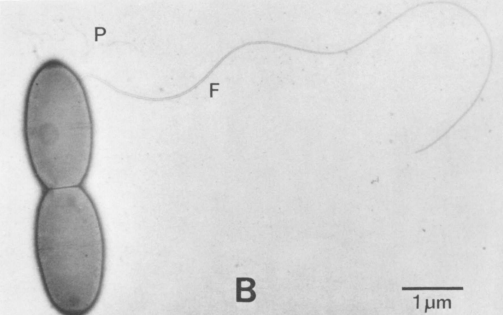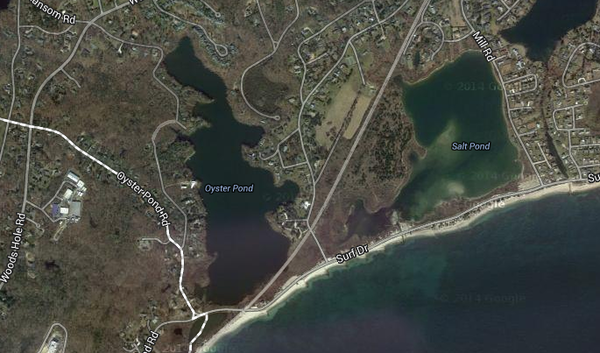Acetobacterium woodii
Classification
Domain: Bacteria
Phylum: Firmicutes
Class: Clostridia
Order: Clostridiales
Family: Eubacteriaceae
Species
|
NCBI: Taxonomy |
Acetobacterium woodii
Isolated from black sediment of Oyster Pond inlet, Woods Hole, MA, USA. Named in honor of Harland G. Wood – An American Biochemist who pioneered studies which proved animals, humans, and bacteria use carbon dioxide in their metabolism. Wood studies proved that carbon dioxide can be used for the complete synthesis of acetate in bacteria.
Description and Significance
Acetobacterium woodii is an anaerobic gram-positive rod-shaped acetogenic bacterium that usually occurs in pairs. Motility is facilitated by one subterminal flagellum, and infrequently exhibits two flagella.
A. woodii produces acetate through homoacetogenic fermentation. The specificity of this microorganisms metabolism has potential industrial applications. Approximately 2 million tons of acetic acid are produced annually with aerobic acetic acid bacteria. A. woodii has the ability to produce acetate anaerobically at a 50% increase in yield compared to aerobic bacteria. This was accomplished through modification of certain genes, over-expressing enzymes in the Acetyl-CoA pathway. Utilizing only H2 gas and CO2, A. woodii could be a more economical alternative to current biotechnological processes.
There is ongoing research into microbial fuel cells (MFCs) and their application as a renewable energy source. Some schemes require an acetate producing microorganisms, for which A. woodii would be ideal.
Genome Structure
A. woodii has circular DNA with 4,044,777 bp.
The density and G+C content was studied using batches containing fructose and H2-CO2 medias. The buoyant density was determined to be 1.699 g/cm3 and the G+C content was 39 mol%.
The proteome consists of 3,473 protein genes within its matrix and the average protein length is 330.5 amino acids.
Cell Structure, Metabolism and Life Cycle
Isolated electron micrographs of A. woodi showed a rare type of peptidoglycan of the cross-linking group-B. This has only been found in one other microorganism; Butyribacterium rettgeri (syn. Eubacterium limosum). Only one difference between the two mureins were partial replacement of D-ornithine by D-lysine in B. rettgeri. The presence of these extremely rare murein types in both organisms indicate a relationship closer than previously thought, based on their similar metabolisms. (Kandler and Schoberth, 1979). The murein makes up 55% of the dry weight of the cell walls.
Grows optimally at 30 degree C in 6 hours under a 80:20 mixture H2-CO2. Most culture media prepared with pH close to neutral (~6.8), but production of acetic acid causes pH to drop. A. woodii was observed to still be viable at pH 5 for weeks.
H2 serves as the electron donor and is oxidized while CO2 serves as the electron acceptor and is reduced to form acetate (syn. acetic acid) through a homoacetogenic fermentation:
2 CO2 + 4 H2 -> CH3COOH + 2 H2O ΔG= -25.6 J/mol
This metabolic pathway is termed the acetyl-CoA pathway. Also known as the Wood–Ljungdahl pathway, after the researchers who pieced together the process.
A. woodii can use substrates other than H2, however the range of substrates is narrow and limited to fructose, glucose, lactate, glycerate, and formate; CO can also serve as a substrate. When the other substrates are used slight production of succinate was detected. The vitamin calcium pantothenate and high bicarbonate concentrations are required for growth.
Ecology and Pathogenesis
Oyster Pond, from which isolation of Acetobacterium woodii was achieved, has some defining characteristics that sets it apart from most other habitats. Oyster pond started as an ocean inlet, with high salinity (~32 ppt). Gradually, storms caused a sandbar to form at the entrance to the inlet, which later was completely closed off from the ocean to allow the building of train tracks. This caused the salinity levels to drop. A weir was then installed to regulate the pond's salinity (between 2-4 ppt).
A. woodii has a dependence on Na+ ions for metabolization of various substrates. Oyster pond's unique levels of salinity may provide an environment better suited for growth of A. woodii than normal freshwater (< 0.5 ppt) and saltwater (~35 ppt) bodies.
Acetogens dominate in many species of termites over methanogens. However, in other communities, methanogenic organisms out-compete acetogenic organisms for H2 due to a higher threshold for hydrogen gas. In addition, some methanogens can metabolize acetate, the fermentive end-product of A. woodii.
Acetobacterium woodii is not pathogenic to humans.
References
Acetate. 2014. [online] Wikipedia. Available at: <http://en.wikipedia.org/wiki/Acetate> [Accessed 20 Apr. 2014].
Acetobacterium woodii (strain ATCC 29683 / DSM 1030 / JCM 2381 / KCTC 1655). 2014. [online] Omabrowser.org. Available at: <http://omabrowser.org/cgi-bin/gateway.pl?f=DisplayOS&p1=ACEWD> [Accessed 20 Apr. 2014].
Balch, W. E., et al. (1977). Acetobacterium, a new genus of hydrogen-oxidizing, carbon dioxide-reducing, anaerobic bacteria. INTERNATIONAL JOURNAL OF SYSTEMATIC BACTERIOLOGY, 27(4), 355-361. Retrieved from http://ijs.sgmjournals.org/content/27/4/355.full.pdf
B R Sharak Genthner, M., 1987. Additional characteristics of one-carbon-compound utilization by Eubacterium limosum and Acetobacterium woodii. Applied and Environmental Microbiology, [online] 53(3), p.471. Available at: <http://www.ncbi.nlm.nih.gov/pmc/articles/PMC203690/?page=1> [Accessed 20 Apr. 2014].
Eden, G. and Fuchs, G., 1983. Autotrophic CO2 fixation in Acetobacterium woodii. Archives of Microbiology, [online] 135(1), pp.68-73. Available at: <http://link.springer.com/article/10.1007%2FBF00419485#page-1> [Accessed 20 Apr. 2014].
Heise, R., et al. (1989). Sodium dependence of acetate formation by the acetogenic bacterium acetobacterium woodii. JOURNAL OF BACTERIOLOGY, 171(10), 5473-5478. Retrieved from http://www.ncbi.nlm.nih.gov/pmc/articles/PMC210386/pdf/jbacter00176-0247.pdf
Kandler, O. and Schoberth, S., 1979. Murein structure of Acetobacterium woodii. Archives of Microbiology, [online] 120(2), pp.181-183. Available at: <http://link.springer.com/article/10.1007%2FBF00409106#page-1> [Accessed 20 Apr. 2014].
Kresge, N., Simoni, R. and Hill, R., 2005. The Discovery of Heterotrophic Carbon Dioxide Fixation by Harland G. Wood. Journal of Biological Chemistry, [online] 280(18), pp.e15-e15. Available at: <http://www.jbc.org/content/280/18/e15.full.pdf+html> [Accessed 20 Apr. 2014].
Oyster Pond Environmental Trust, Inc. 2014. [online] Opet.org. Available at: <http://www.opet.org/facts.html> [Accessed 20 Apr. 2014].
Poehlein, A., et al. (2011, July). Acetobacterium woodii (strain ATCC 29683 / DSM 1030 / JCM 2381 / KCTC 1655). Retrieved from http://hamap.expasy.org/proteomes/ACEWD.html
Spormann, A., et al. (2014). GCEP Research » Blog Archive » Capturing Electrical Current via Microbes to Produce Methane. [online] Stanford.edu. Available at: http://www.stanford.edu/group/gcep/cgi-bin/gcep-research/all/capturing-electrical-current-via-microbes-to-produce-methane/ [Accessed 22 Apr. 2014].
Straub, M., et al. 2014. Selective enhancement of autotrophic acetate production with genetically modified Acetobacterium woodii. [online] Sciencedirect.com. Available at: <http://www.sciencedirect.com/science/article/pii/S0168165614001084> [Accessed 20 Apr. 2014].
Author
Page authored by Jacob Bryde and Tim Stieve, students of Drs. Kaz Kashefi and Edward Walker at Michigan State University.



